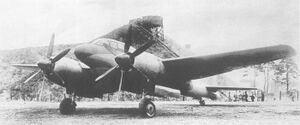Engineering:Rikugun Ki-93: Difference between revisions
NBrushPhys (talk | contribs) (over-write) |
(No difference)
|
Latest revision as of 21:43, 25 November 2022
| Rikugun Ki-93 | |
|---|---|

| |
| The prototype before flying | |
| Role | Heavy fighter |
| National origin | Japan |
| Manufacturer | Army Aerotechnical Research Institute |
| First flight | 8 April 1945 |
| Status | Cancelled |
| Primary user | Imperial Japanese Army Air Service (intended) |
| Number built | 1 |
The Rikugun Ki-93 was a prototype Japan ese twin-engined fighter aircraft of the Second World War. Designed by the Army Aerotechnical Research Institute, to be a heavy fighter armed with large calibre cannon to serve in the anti-shipping or bomber destroyer roles, only one example of the Ki-93 was completed; this was damaged on its maiden flight, and destroyed by American bombing before it could be flown again.
Development and design
In mid 1941, a team was set up at the Japanese Army Aerotechnical Research Institute (or Rikugun Kokugijutsu Kenkyujo, known by the abbreviation Giken) to study advanced military aircraft. The team drew up preliminary designs for a twin-engined heavy fighter for the Imperial Japanese Army Air Service, to be powered by two Mitsubishi Ha-211 radial engines and estimated to reach a speed of 680 km/h (422 mph). In July 1942, the design, along with some of the team from Giken, was passed to the First Army Air Arsenal (Dai-Ichi Rikugun Kokusho or Kosho) at Tachikawa for further development. Here, the design was refined, with more powerful Mitsubishi Ha-214 radials substituted and a heavy cannon armament added.[1]
Approval to build prototypes of the new fighter, designated Ki-93, was given on 22 February 1943.[2] The Ki-93 was a low-winged monoplane of all metal construction, with the crew of two sitting in tandem under a canopy at the front of the fuselage, and a ventral gondola slung under the fuselage to accommodate large cannons. The wing was of laminar flow section.[2] Two variants were planned, the Ki-93-Ia bomber destroyer, armed with a 57 mm and two 20 mm cannon, and the Ki-93-Ib anti-shipping aircraft, which would have a 75 mm gun in the gondola and would also carry two 250 kg (550 lb) bombs.[3]
The first prototype proved to be overweight, while the new engines gave much less power than expected, delivering only 1,970 hp compared with the expected 2,400 hp. The Ki-93 made its first flight on 8 April 1945 from Tachikawa airfield; a successful 20 minute test of its low-speed handling characteristics, piloted by Lt. Moriya of the Koku Shinsa-bu (Air Examination Department) with 2nd Lt. Ikebayashi in the second seat. Unfortunately, the pilot undershot the runway and touched down in soft soil, ground-looping the aircraft and tearing off the port undercarriage leg and engine mount, also bending the six-blade propeller. Repairs were completed in four weeks but, the night before the scheduled second test flight, a B-29 bombing raid on Tachikawa destroyed the hangar housing the aircraft.[4]
Specifications (performance estimated, Ki-93-Ia armament)
Data from Japanese Aircraft of the Pacific War.[5]
General characteristics
- Crew: 2
- Length: 14.215 m (46 ft 8 in)
- Wingspan: 19.00 m (62 ft 4 in)
- Height: 4.85 m (15 ft 11 in)
- Wing area: 54.75 m2 (589.3 sq ft)
- Empty weight: 7,686 kg (16,945 lb)
- Gross weight: 11,440 kg (25,221 lb) [6]
- Powerplant: 2 × Mitsubishi Ha-214 18-cylinder air-cooled radial engine, 1,470 kW (1,970 hp) each (take-off power)[6]
- Propellers: 6-bladed VDM, 3.80 m (12 ft 6 in) diameter [6]
Performance
- Maximum speed: 624 km/h (388 mph, 337 kn) at 8,300 m (27,200 ft)
- Cruise speed: 350 km/h (220 mph, 190 kn) at sea level
- Range: 3,000 km (1,900 mi, 1,600 nmi)
- Service ceiling: 12,050 m (39,530 ft)
- Time to altitude: 9 min 3 sec to 6,000 m (19,700 ft)
Armament
- Guns:
- 1× 57 mm Ho-401 cannon in ventral gondola
- 2× 20 mm Ho-5 cannon in wing roots
- 1× 12.7 mm Ho-103 machine gun on flexible mounting in rear cockpit
See also
Aircraft of comparable role, configuration and era
- Bristol Brigand
- de Havilland Mosquito FB Mk XVIII
- Henschel Hs 129B-3
- Kawasaki Ki-102
- Junkers Ju 88P
- Mansyū Ki-98
- North American B-25G/H
Notes
- ↑ Air International May 1977, p.252.
- ↑ 2.0 2.1 Air International May 1977, p.254.
- ↑ Francillon 1970, p.244.
- ↑ "A Japanese rara avis...The Giken Fighter", AIR International, Bromley, Kent, UK, May 1977, Volume 12, Number 5, pages 254-255 .
- ↑ Francillon 1970, p.245.
- ↑ 6.0 6.1 6.2 Air International May 1977, p.253.
References
- Francillon, René J. Japanese Aircraft of the Pacific War. London: Putnam & Company, 1970. ISBN:0-370-00033-1.
- "The Giken Fighter". Air International, May 1977, Vol 12 No. 5. pp. 251–255.
External links
 |

